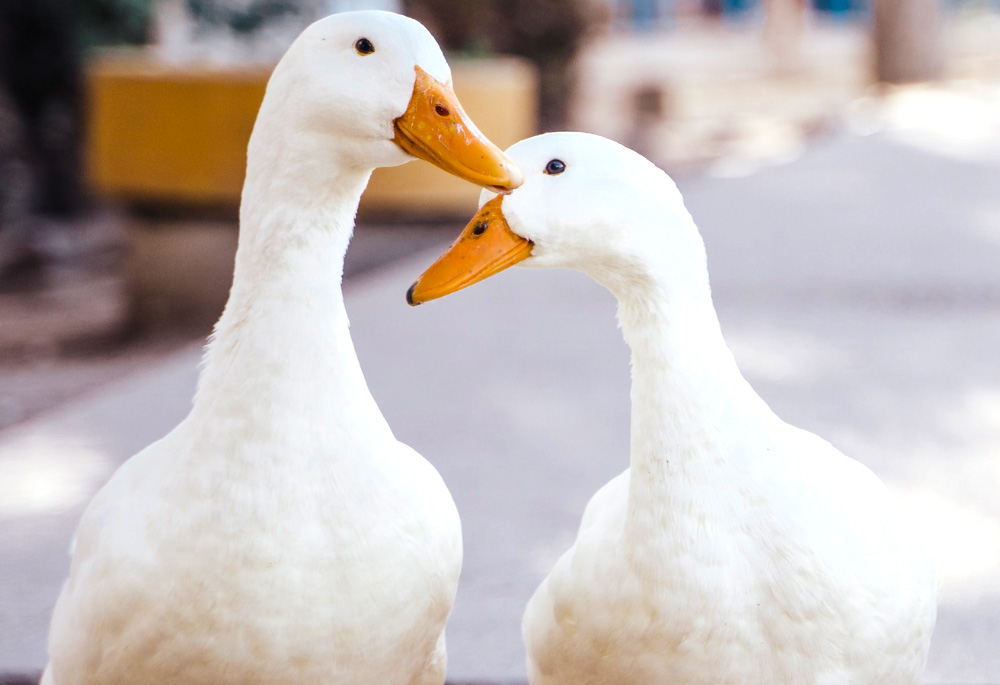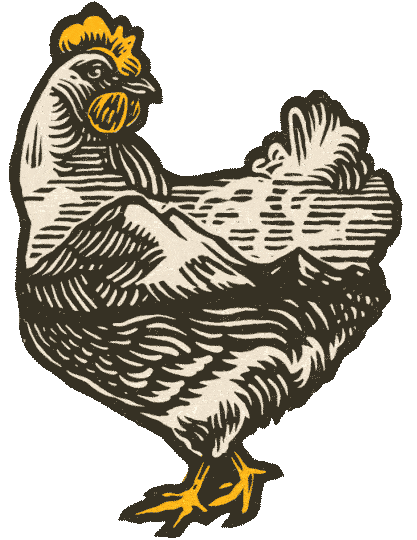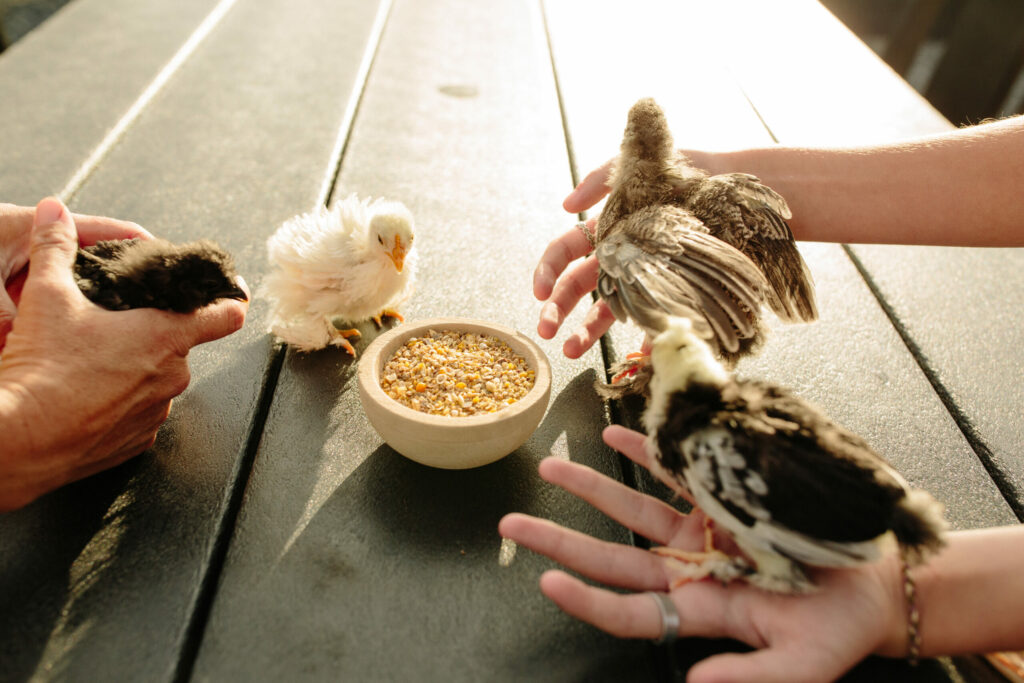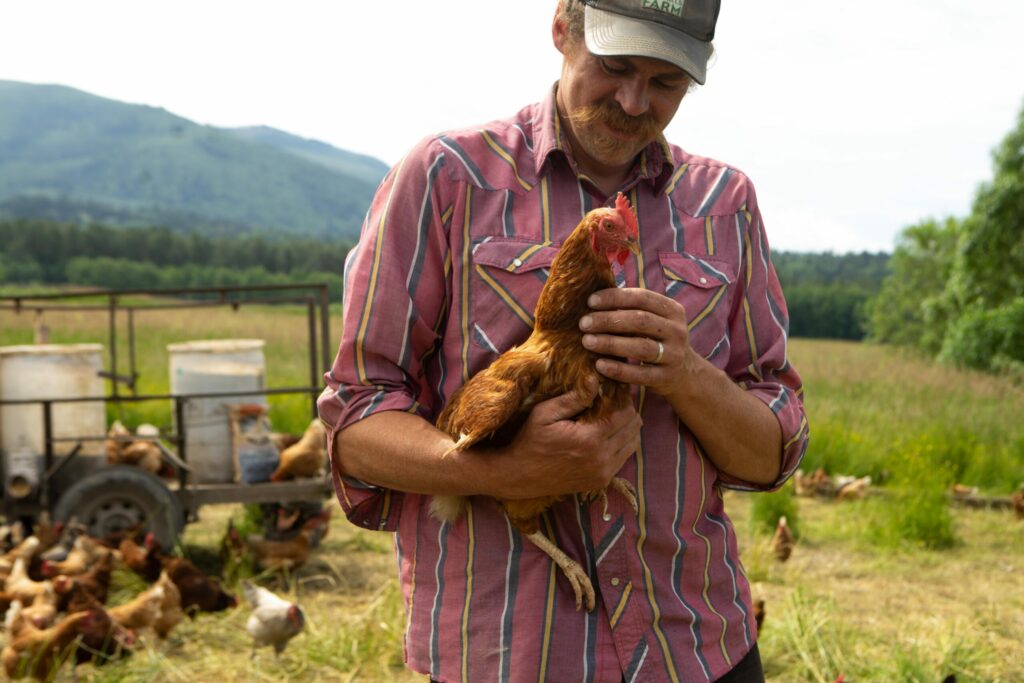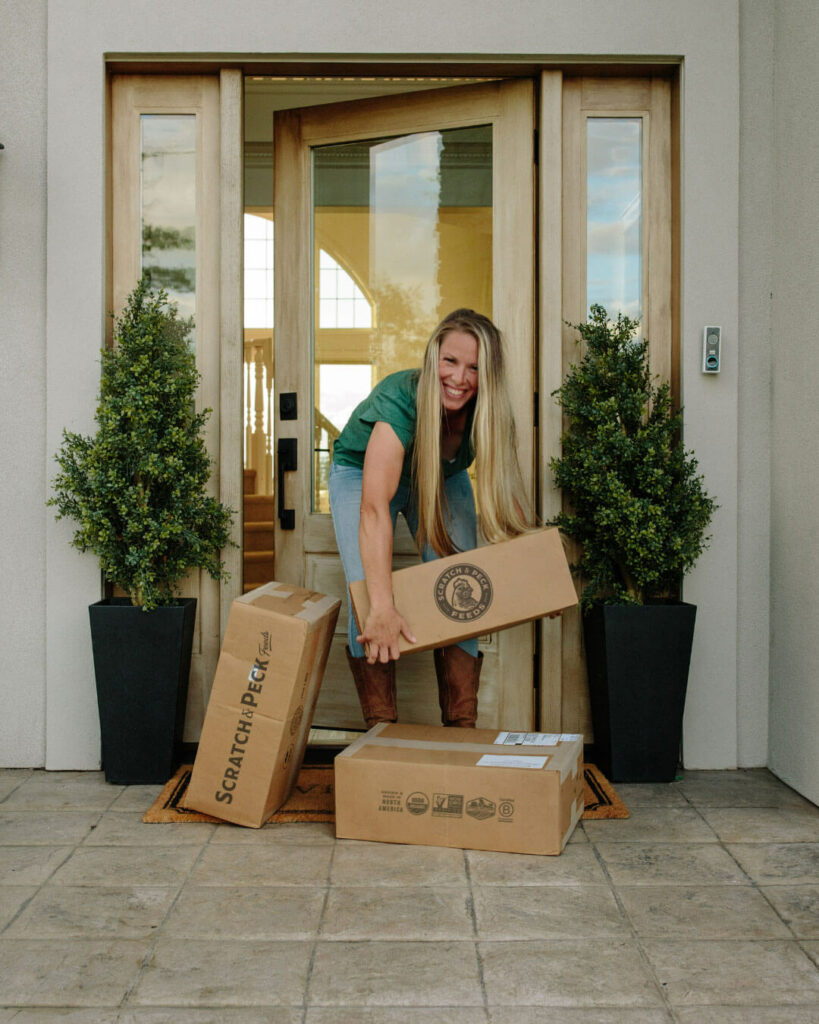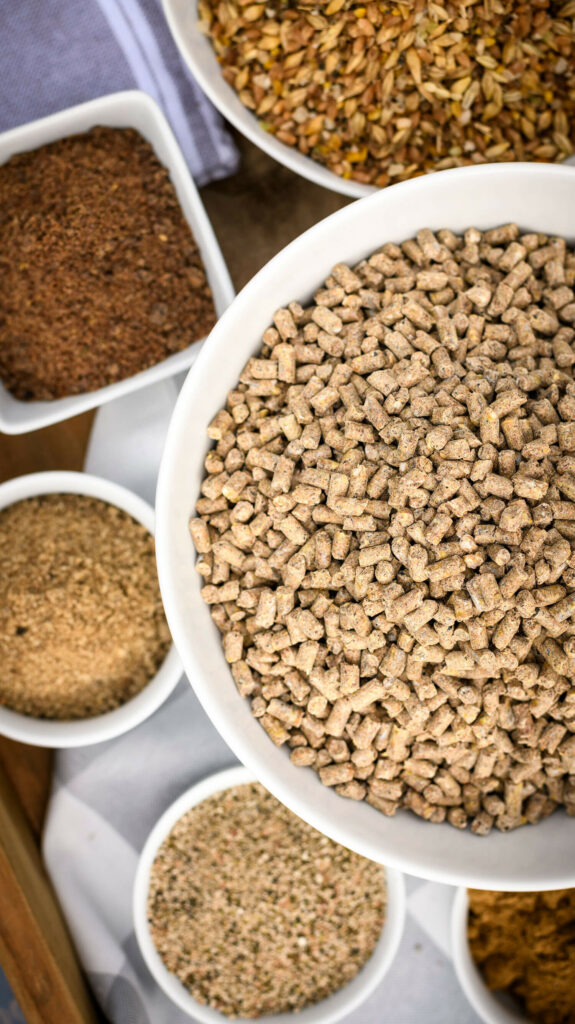Domestic Ducks in the Wild – Is there a wide variety of waterfowl at your local pond? Do you see birds that look different from mallards and Canada geese? If so, they are likely domestic birds, purchased from farm stores and left to fend for themselves by well-meaning people who could not – or would not – continue to care for them. Duck-dumping is a persistent problem caused by a lack of understanding on the consumer’s part and a lack of education and responsible sales on the supplier’s part. It is important to know that dumping domestic ducks is illegal in most states.
This article covers why domestic ducks can’t survive in the wild (including city ponds), how to spot the difference between domestic and wild ducks, examine reasons for duck dumping, and offer ideas on how you can help.
A Pond Is a Duck’s Natural Habitat… Right? – Wild ducks (mallards) often congregate at ponds. Water offers safety from land-dwelling predators and is a likely place to grab a meal. Aquatic plants, small fish, and crustaceans are all in the natural diet of waterfowl.
However, domestic ducks do not have a “natural” habitat; they were bred as livestock for either egg or meat production. Domestic ducks cannot fly and do not have any wild instincts, unlike their wild cousins. (Fact: did you know that goose and duck were the preferred meat choice over turkey and chicken until the 1950s? They are still popular in many countries.)
Like other livestock, they were bred to depend on human care to survive. However, even though the domestic duck does not have a natural habitat, they do have specific environmental and nutritional needs. A human must provide for these needs, as domestic ducks cannot migrate to different environments in search of food and safety. Thinking that a domestic duck belongs in a “natural” pond habitat, where it can be wild and free, is equivalent to assuming that your pet dog belongs in the wilderness, where it can “naturally” hunt down deer and rabbits, like its coyote or wolf cousins. The domestic duck has even less chance of surviving in the wild than your Labrador. Domestic ducks have zero ability to defend themselves: they do not have teeth as dogs do. They cannot run faster than an awkward speed-waddle, nor can they fly away to escape a predator attack.
Domestic ducks can forage as mallards do, and this activity is healthy for them. However, because they cannot fly, they are stuck in whatever location they were left. When food runs out, they cannot go in search of it somewhere else. They often starve in the cold winter months when park ponds do not have many visitors. Add to this the fact that ducks have been bred to be producers, so they have far higher nutritional and caloric requirements than the small, wild mallard. They will face hunger and severe health conditions sooner than their wild counterparts.
Predators and food aren’t the only problems – If predators do not pick them off, domestic ducks will struggle to find adequate food to survive. But even if they can find food, they will inevitably contract disease or infection.
Skewed Ratios – Female domestics are especially vulnerable. Males ducks (drakes) are famously aggressive in the mating department – some more than others. It is important to keep a good balance of male to female ducks (this ratio largely depends on the temperament of the individual male, but 1:3 is about right). The natural hormonal aggression of drakes also means that most dumped ducks are male. People end up with too many boys and cannot manage their behavior toward the females. Sometimes drakes are discarded for the sad reason that they were unsexed as ducklings. They may be perfectly gentle drakes, but only egg-producing females are desired, so the boys get thrown out like trash.
The male-to-female ratio becomes tremendously skewed as ponds get increasingly crowded with mallards and dumped domestics.
Females are frequently over-mated, resulting in feather loss and lacerations that may become infected. Sometimes, their end is a horrific death of being drowned by competing males.
Overcrowding Breeds Competition – Duck dumping not only harms domestic ducks, but also compromises the wild population. Feeding ducks at the ponds is necessary for domestic ducks to survive (if it is quality food: I’ll get to that in a second). However, feeding wild ducks delays migration, which creates more competition for food, overcrowding, and accelerates disease spread. It’s tough to feed domestic ducks without also feeding wild ducks. The best solution I can give you is: don’t dump ducks. Domestic and wild ducks will mate, creating hybrid breeds that are also unable to migrate, weakening the gene pool of wild waterfowl.
As waterfowl populations begin to spiral out of control at ponds, the water quality deteriorates and becomes a petri dish of E-coli, ammonia, and – in hot, stagnant ponds – botulism.
Ponds Are Not Safe Havens – Droppings in overpopulated parks become intolerable for humans, so cities will round up both domestic and wild birds, euthanizing them through a painful gassing process. So, that duck you left at the pond may have miraculously survived for weeks, only to be put in a gas chamber by the city.
What is the difference between domestic and wild ducks?
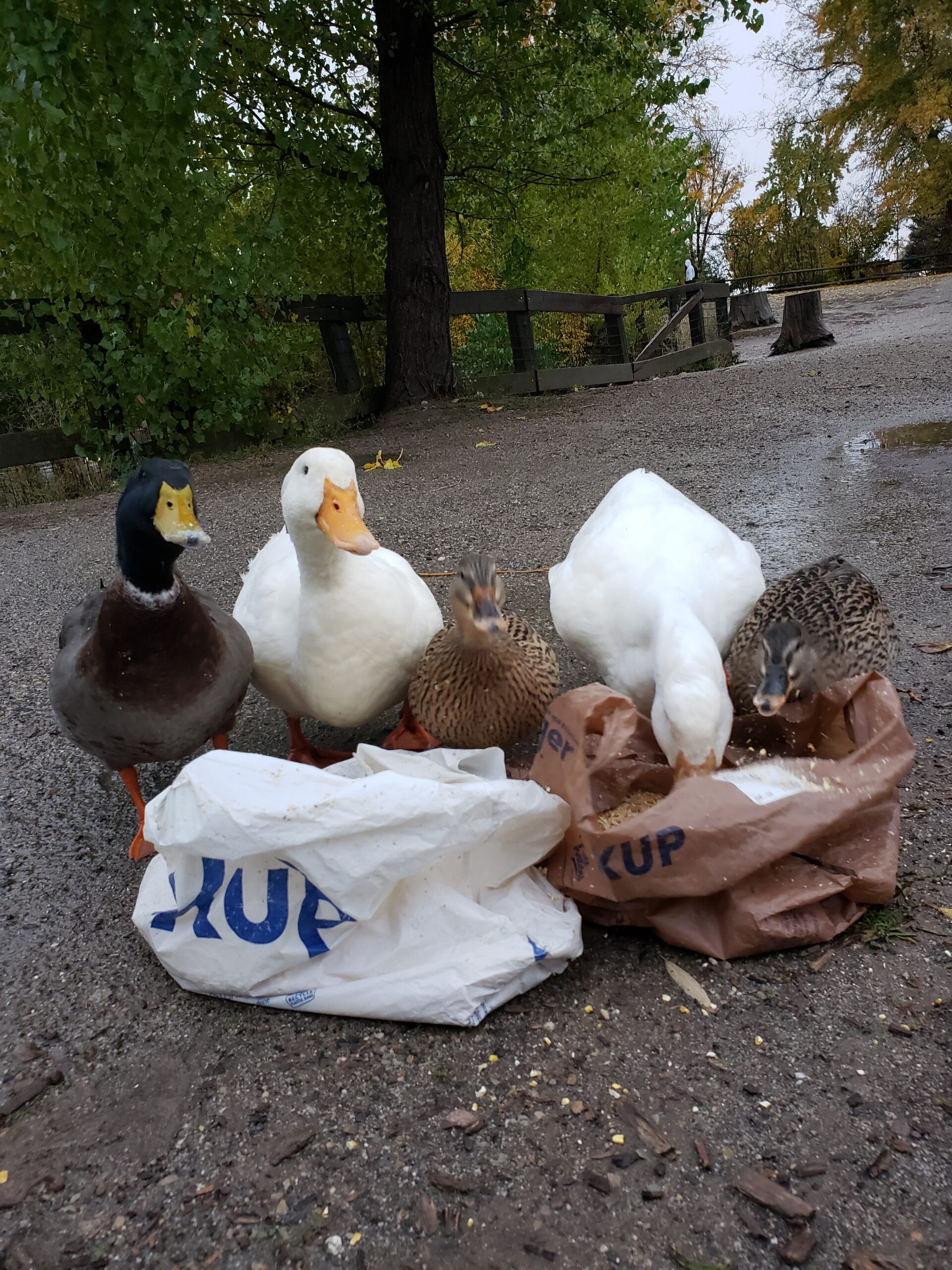
Now that you understand why domestic ducks do not belong outside of loving homes with humans to care for them, let’s learn how to tell domestic ducks apart from the wild.
Wild – The simplest way to tell wild ducks from domestics is their ability to fly. All wild ducks can fly. They will also be quite a bit smaller than most domestic breeds. If you see a large duck that is two to four times bigger than a flighted mallard, it’s safe to say they are a domestic duck.
Coloring can also be an indicator that a duck is domestic. For instance, every white duck (with the exception of an albino or leucistic wild mallard) is a domestic duck. White is a highly visible color to predators and does not provide camouflage, so it is not a natural color for duck plumage.
Domestic ducks come in more colors than just white. They can have any color of plumage. If you see a duck that does not have traditional mallard plumage, that can be indicative of a domestic duck.
The most common breed of wild duck is the mallard. Females have speckled brown feathers and orange bills; males have bright green heads, brown feathers with blue and white stripes on the wings, and greenish bills. Males go through an eclipse molt in late summer, trading their colorful green head feathers for brown. At first glance, they look like females, but you can tell them apart by the bill color and the sound of their voice (males have a low, raspy voice, females have the quintessential loud QUACK).
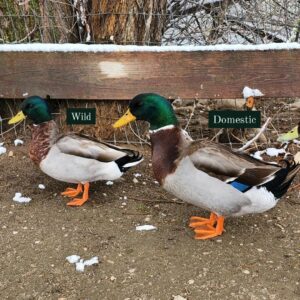
Mallards measure about 20 inches long and weigh 2-3 pounds. They have a very horizontal posture, whereas domestics have a more upright posture.
Domestic – The domestic duck that looks the most similar to the mallard is the Rouen: they have nearly identical coloring. However, Rouens are much larger (up to three times the size of a mallard) and have a more upright posture. Domestic ducks can have a wide variety of coloring: black, white, mottled, and all shades of brown and gray.

The most significant indicators will be their posture (more upright), inability to fly, lack of athletic-ness, and size.
Identification can be tricky if you are not a duck expert. Some domestics can be small and have similar coloring to mallards. Hybrid ducks (mallard and domestic offspring) can be even tougher to classify.
The best rule of thumb is if the duck is the size of a mallard and you can see it fly, it is likely a wild duck. I had recently started following a few duck rescue groups on Instagram: Amy from Puddle Ducks Rescue, RaeAnn from For Duck’s Sake, and Adison with Wasatch Wanderers. The issue of domestic duck dumping was heavy on my mind, so I made a point of scanning the ponds on my way to and from town.
Our rescue duck, Fergie, was very easy to spot and caught my attention as I was driving past the local city pond.
I pulled into the parking lot, utterly unprepared for duck rescue. I had no net to catch her with. No box to put her in. Just me and my empty Prius. I had some duck experience and a lot of goose experience, and one thing I know is that they will come for food. But I did not have any food. Still, I wanted to try. I approached slowly, and she looked at me curiously. She was wary, and as soon as she started to retreat, I stopped and knelt on dirt, holding out my hand as if I had something tasty to give her. She approached cautiously, stretching her neck out as far as she could to see what I had without getting too close. When she saw the empty contents of my cupped hand, she immediately lost interest. I thought about going home, grabbing some mealworms, and returning. But I didn’t want to abandon her. What if she retreated into the pond? So, I scooped up a handful of pine needles and dirt and held my offering out to her, hoping that she would come closer. It worked. She saw something in my hand and came close enough to take a cautious nibble of the dirt.
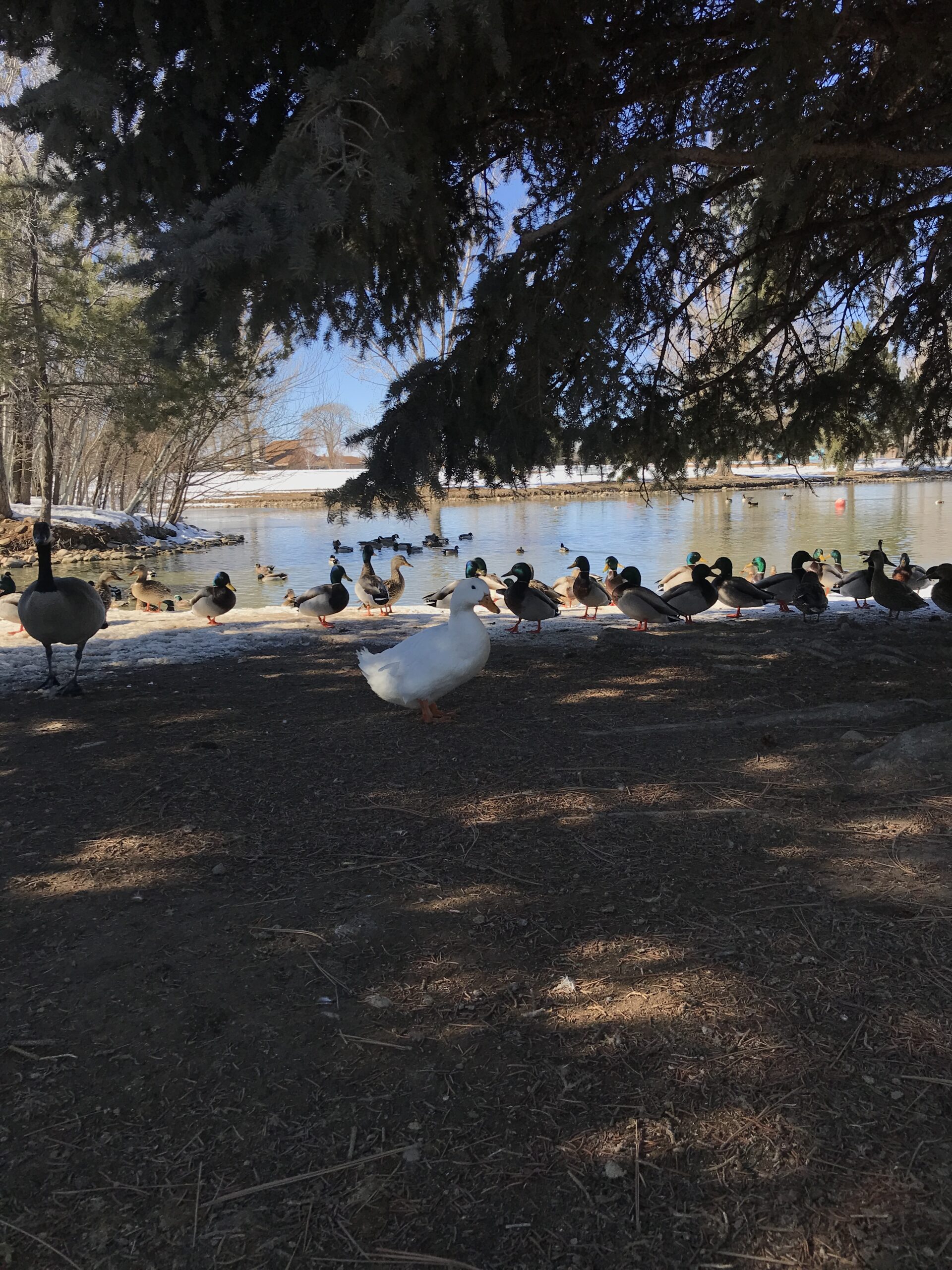
Finally! I was able to grab her.
She rode home with me, perched on the car console. I couldn’t believe I had been successful. She didn’t even poop on the drive home – it was a miracle all the way around. When we got home, I gave her a lettuce bath (a bathtub filled with cool, clean water and a sprinkling of chopped lettuce) and inspected her for injury. She had abrasions under her wings (likely from being flattened on the ground as males mated her) and two small, pre-bumble sores on the bottom of her feet. It was clear that she had not been abandoned for long; she was very trusting; wary, but not frightened. And her injuries were minor – dumped ducks are usually in much worse shape.
Why do people dump ducks?
At one time, Fergie had been loved by a human. I believe most dumped ducks have been.
Then, at some point, they became… Inconvenient? Too hard to care for? Ducks are not low-maintenance animals, and I think most people underestimate the level of commitment required. Ducks are messy and require a lot of water. They need a safe place at night with clean, deep bedding. They need adequate space with soft ground for their feet. They eat a lot and need high-quality food. They have health problems brought on by genetics that work against them, including heavy bodies and constant egg production, which saps a lot of energy and nutrients.
Social media is full of cute duckling videos. Farm stores have adorable, fluffy ducklings at low prices, encouraging impulse buys. People do not realize that ducklings grow up, get messier, poop more, and require more space. There is little understanding of drake behavior or the ratio of males to females needed to maintain a healthy flock. When people decide they will no longer care for their ducks, most animal shelters will not take them. They believe that the ducks will do just fine at the local pond because that’s where ducks live!
What You Can Do
Educate – Most people genuinely believe that domestic ducks will be okay without human care. Ask farm stores to post signs educating customers on duck care. 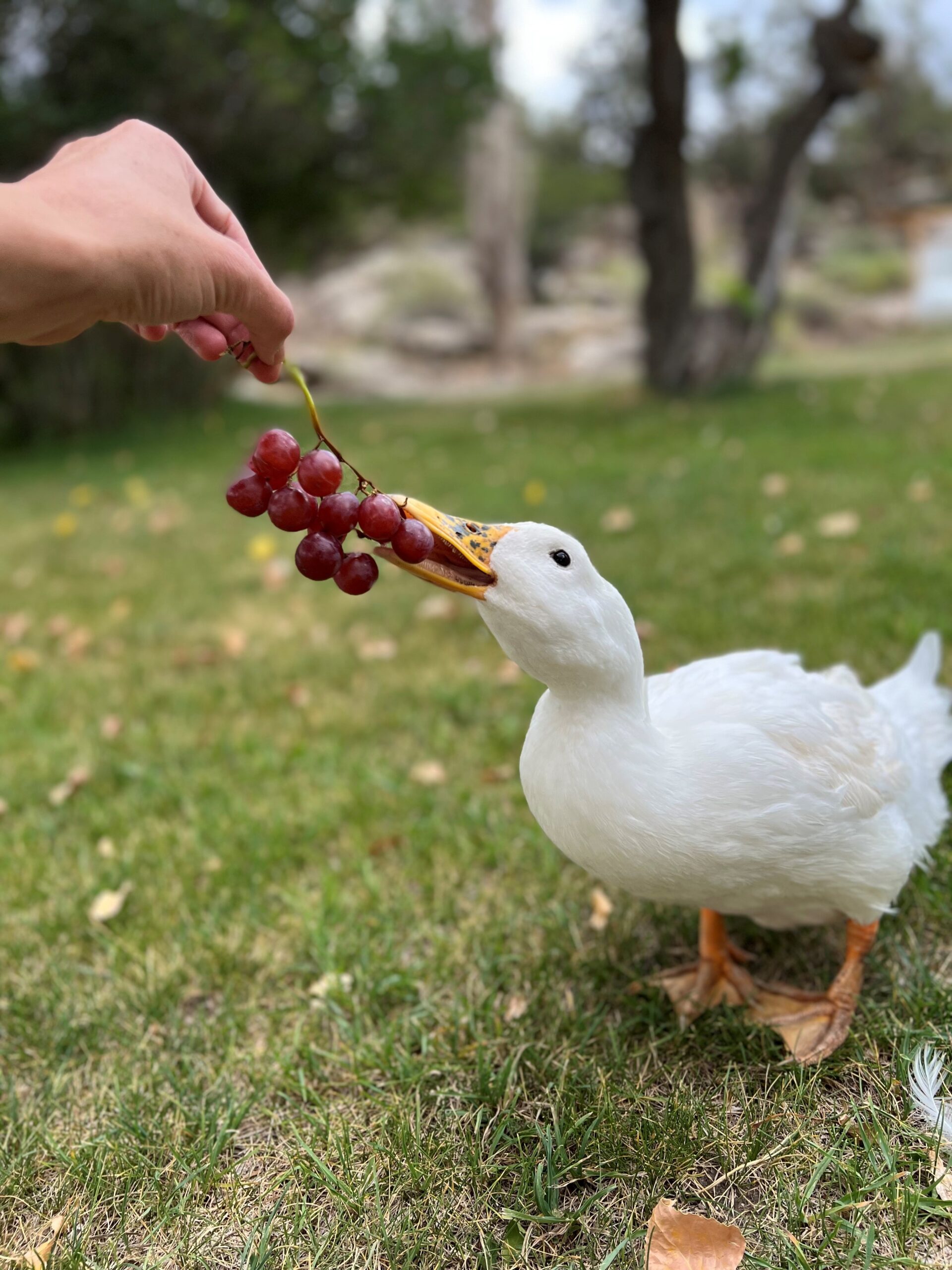 Ask your city park to post signs at the ponds to notify the public that duping ducks is illegal and is a death sentence.
Ask your city park to post signs at the ponds to notify the public that duping ducks is illegal and is a death sentence.
Share – Follow rescue groups and share their posts and stories. Ask influencers to become duck advocates.
Care – Take some good food for domestic ducks at ponds: cracked corn, lettuce, peas, or waterfowl feed. Do not feed them bread or popcorn: the empty calories lead to nutritional deficiencies. If you can – rescue a duck yourself or help a rescue group.
Foster and Adopt – Adopt, don’t shop! The number of domestic waterfowl needing homes is immense. Consider fostering if you can’t commit long-term – rescuers are out of space most of the time. If you can adopt, consider an all-male flock. So many drakes need homes and can do quite well without females. This way, you don’t have to worry about a proper drake-to-duck ratio.
Rescuers – A huge thank you to Amy from Puddle Ducks Rescue (@puddleduckrescue), who was not only the first duck rescue account I followed on Instagram and inspired me to rescue our beloved Fergie, but has answered many duck-related questions for me. She also reviewed this article and provided many of the pictures. Also, Adison from Wasatch Wanderers (@wasatchwanderers), from whom we got two rescue ducks, Puddles and Gompers. RaeAnne from For Duck’s Sake (@for_ducksake), who is a constant inspiration of animal compassion.
These were the first waterfowl rescue accounts I found on Instagram, though I now follow many others. Without their continuous education on social media, I would be far less aware of the waterfowl dumping crisis that is happening across the country.
Find a Rescue or Sanctuary Near You:
Adopt a Bird Network @adoptabirdnetwork
California – California Waterfowl @california.waterfowl or Healing Hearts Farm Sanctuary @healingheartsfarmsanctuary or Vargas Ranch Rescue @vargasranchrescue
Colorado – Broken Shovels Farm Sanctuary @brokenshovels
Connecticut – Majestic Waterfowl Sanctuary @majestic_waterfowl_sancuary
Oregon – OTP Sanctuary @otpsanctuary
New York – Arthur’s Acres Sanctuary
Goosepond Mountain Sanctuary @goosepondmountainsanctuary
Pennsylvania – Kindred Spirits Rescue Ranch @kindredspiritsrescueranch
South Carolina – Carolina Waterfowl Rescue @waterfowlrescue
Utah – For Duck’s Sake @for_ducksake
Puddleducks Rescue @puddleducksrescue
Wasatch Wanderers @wasatchwanderers
This is by no means a comprehensive list. Follow and show some love to these accounts that are fighting to keep domestic ducks out of ponds and placed in loving homes. I hope this article can pay it forward by giving you, the reader, awareness, knowledge, and resources to keep spreading the word.
About the Author
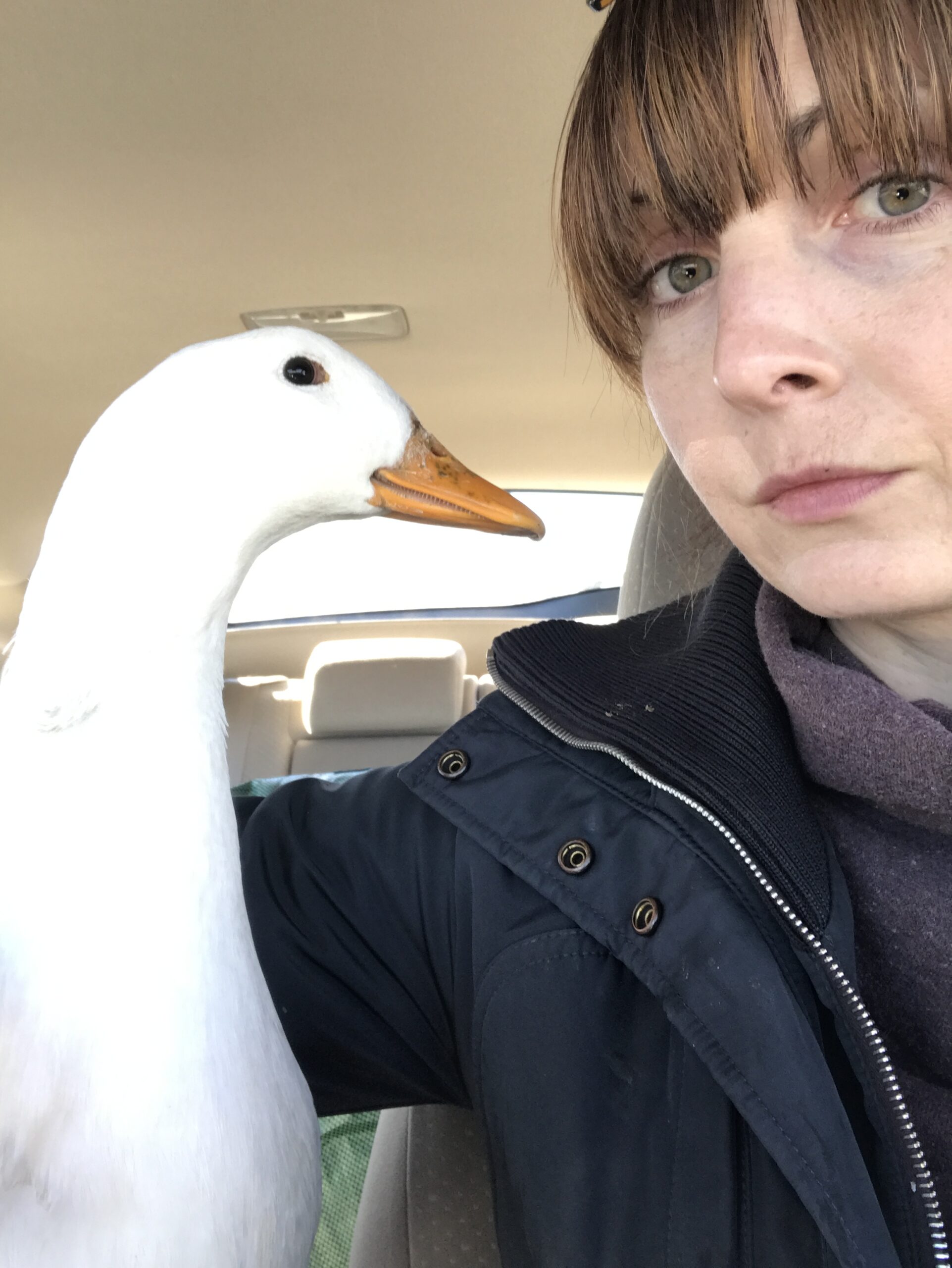 A former city girl into fashion, snobbish coffees, and hot yoga, MJ never thought she’d end up in rural Colorado wearing Carharrts, picking apples, scooping animal poop… and liking it. She has loved geese since she tentatively brought home four goslings in 2018 to graze their orchard. While she has considered geese the indispensable centerpiece of their historic 5-acre homestead, she has a soft spot in her heart for dumped ducks.
A former city girl into fashion, snobbish coffees, and hot yoga, MJ never thought she’d end up in rural Colorado wearing Carharrts, picking apples, scooping animal poop… and liking it. She has loved geese since she tentatively brought home four goslings in 2018 to graze their orchard. While she has considered geese the indispensable centerpiece of their historic 5-acre homestead, she has a soft spot in her heart for dumped ducks.
MJ and her husband have one highly entertaining and precocious toddler, one gentle giant guardian dog, three rescue ducks, two chickens, two feral guineas, a few cute sheep, and, at any time, 12-20 highly entertaining (but not precocious) geese. She has her BA in Economics from the University of Colorado at Denver and a robust background in vocal performance and fine art.
